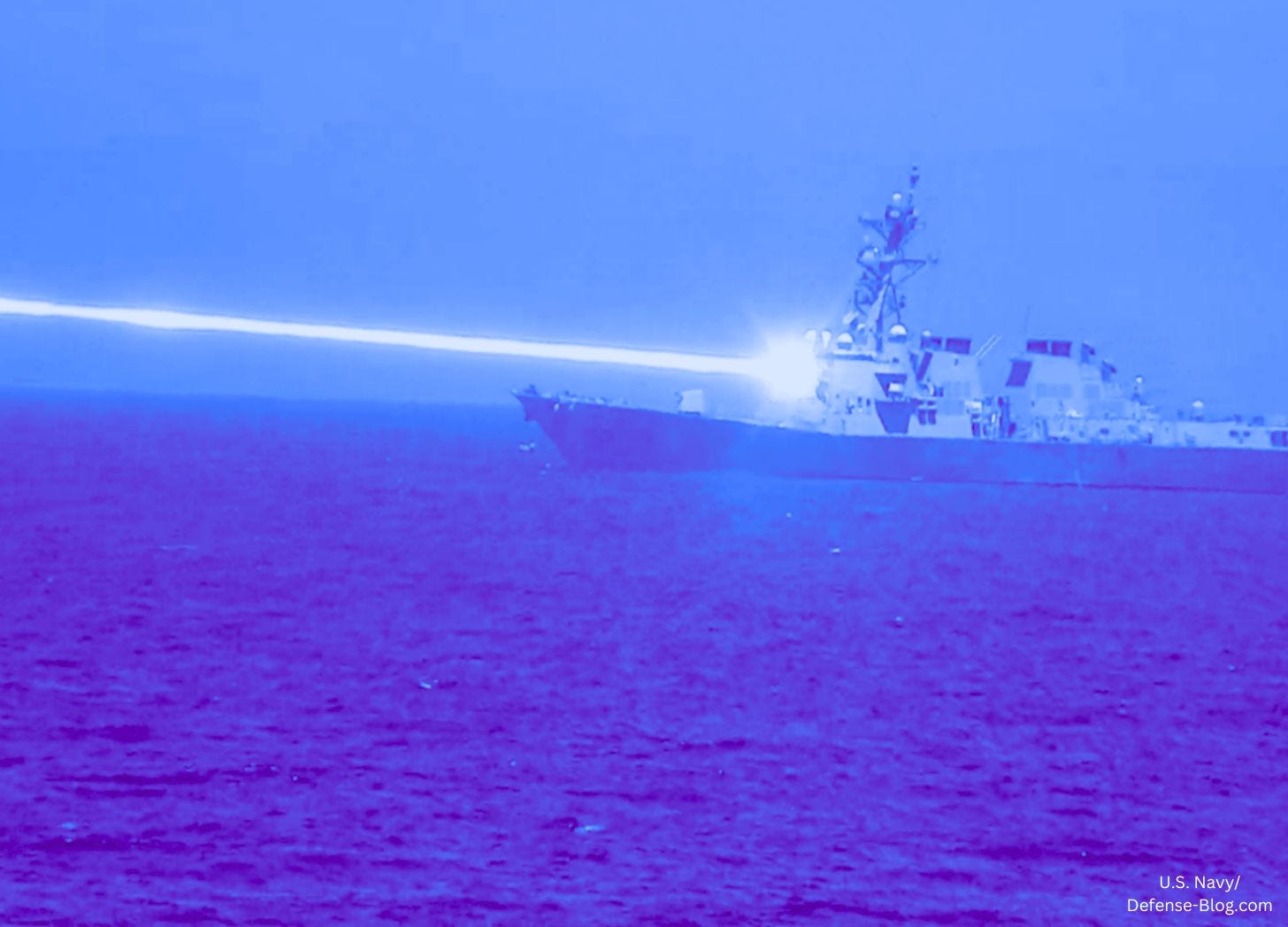U.S. Navy Deploys HELIOS Laser Weapon System Amid Rising Directed Energy Arms Race
DEWs aren't science fiction.
The U.S. Navy has now confirmed its deployment of the High Energy Laser with Integrated Optical Dazzler and Surveillance (HELIOS) system aboard the Arleigh Burke-class destroyer USS Preble (DDG-88), bringing a 60-kilowatt directed energy weapon into active service.
Follow Jon Fleetwood: Instagram @realjonfleetwood / Twitter @JonMFleetwood / Facebook @realjonfleetwood
According to the U.S. Center for Countermeasures (CCM), HELIOS has been tested against an unmanned aerial vehicle (UAV) target in a demonstration conducted on the USS Preble.
The newly released report states: “CCM supported the Navy’s demonstration on USS Preble (DDG 88) to verify and validate the functionality, performance, and capability of the HEL with Integrated Optical Dazzler and Surveillance system against an unmanned aerial vehicle target. CCM collected imagery of the engagements to support the evaluation of system performance,” per Defense Blog.
The U.S. Navy also released a new photograph showing the USS Preble firing the HELIOS laser into the sea, confirming the weapon’s operation.
However, key details, such as when the photo was taken, remain undisclosed.
What is clear is that Washington is now heavily invested in rolling out this next-generation directed energy weapon, which is integrated with the Aegis combat system for increased tracking, targeting, and engagement capabilities.
HELIOS: A New Tier of Electronic Warfare
HELIOS, developed by Lockheed Martin under a $150 million contract awarded in 2018, is one of the latest entries in the Pentagon’s growing arsenal of directed energy weapons.
While initial power levels stand at 60 kilowatts, the system is designed to scale up to 120 kilowatts—posing serious questions about the next stage of military combat and control.
Unlike traditional missile-based defense systems, laser weapons like HELIOS offer rapid engagement speeds, lower per-engagement costs, and a virtually unlimited magazine—as long as power is available.
But the implications extend far beyond mere cost efficiency.
The weapon features both “hard kill” and “soft kill” functions—the ability to either physically destroy a target or disable its sensors through optical dazzling, according to BulgarianMilitary.com.
This means HELIOS can not only shoot down drones and small boats but also blind surveillance equipment and disrupt enemy targeting systems, shifting the balance of modern warfare toward more silent, electronic-based engagements.
A Coordinated Push for Directed Energy Weapons
HELIOS is not an isolated development.
The U.S. Navy has been rapidly expanding its use of high-energy laser weapons across its fleet, adding systems such as the 150-kilowatt Laser Weapon System Demonstrator (LWSD).
This acceleration raises concerns about the increasing reliance on directed energy weapons for battlefield supremacy.
Meanwhile, other nations are not sitting idly by.
The global arms race for laser technology is heating up:
United Kingdom – The “DragonFire” system, tested successfully in early 2024, delivers 50 kilowatts of power and has been fast-tracked for deployment by 2027.
Israel – The “Iron Beam” laser system, developed to work alongside the Iron Dome missile defense, is designed to shoot down rockets, mortars, and drones at a lower cost per engagement.
China – Claims to have developed a laser weapon that can fire indefinitely due to an advanced cooling system, though this has yet to be publicly demonstrated.
Russia – Reportedly working on high-energy lasers with a focus on blinding adversary satellites and space-based systems.
Germany – Rheinmetall is developing stationary and mobile laser weapons for counter-drone and anti-artillery defense.
India – The “DURGA II” laser project is intended for deployment with the Indian Army to counter aerial and ground-based threats.
Turkey – Roketsan’s ALKA system integrates laser and electromagnetic weapons for counter-drone operations.
South Korea, Japan, and Australia – All actively working on their own laser-based defense programs.
The global expansion of directed energy weapons underscores a shift away from conventional warfare toward electronically controlled, high-speed engagements.
These systems—often marketed as ‘cost-effective’ solutions—create a battlefield dynamic where power grids and surveillance networks become primary targets.
Pentagon’s Use of Directed Energy Weapons on American Soil
Science fiction has become reality as reports now suggest that directed-energy weapons were deployed against American citizens during the 2020 riots.
A Blaze exclusive investigative report by Steve Baker and Joe Hanneman uncovered that the Pentagon approved the use of these weapons for riot control in June 2020.
Journalist Jill Savage summarized the findings: “We all remember 2020, the summer of love, the burning buildings, all the looted stores, and an overall lack of legal consequences for crimes committed by rioters. However, in a Blaze exclusive, Blaze investigative journalists Steve Baker and Joe Hanneman revealed that the Pentagon approved the use of directed-energy weapons on rioters in June of that year.”
Baker, who initially investigated the January 6 Capitol riot, stumbled upon this information while following unrelated leads.
“My curiosity began to just lead me down a number of rabbit holes, and I began to pull a lot of threads, and throughout that process, I began to discover that there were new types of systems that I was not aware of that could be used to both control crowds as riot control but also had other uses to move people in ways that maybe the American public are not aware of,” Baker stated.
The technology itself isn’t new, the Blaze report points out.
In the 1950s, the Soviet Union actively developed psychotronic weapons—energy-based systems capable of influencing or harming human targets.
Following the USSR’s collapse in 1991, many Soviet scientists sold this research to the U.S. government.
“Elements of our government were able to purchase advanced technology in what they call the directed-energy weapons space, and some of that was much more advanced technology than what we have,” Baker explained, adding that today’s versions are significantly more sophisticated.
Video evidence from 2020, captured by Blaze correspondent Julio Rosas, showed an audio energy weapon blasting at ultra-high sound levels to disperse crowds in Kenosha.
Beyond audio-based devices, microwave weapons have been used to create a sensation of burning skin.
“There are microwave versions of that that they can blast at you and make you for a two-second pulse, it makes your skin feel like you’re on fire,” Baker warned.
These systems have since become even more portable.
“Now they have backpack size, and what some of these special operatives have described to me in great detail are what they call agitation weapons. And this is the thing that we fear the most,” he continued.
These weapons, once used overseas in military and CIA operations to incite unrest and influence movements in foreign countries, may now be used within U.S. borders.
The Risks and Realities of HELIOS
Despite the Navy’s public enthusiasm for these weapons, the implications of directed-energy technology extend far beyond what is being disclosed.
The U.S. military has a long history of weaponizing experimental projects against its own citizens—Operation Sea-Spray, where Americans were secretly exposed to bacterial warfare agents, MKUltra, the CIA’s covert human experimentation program, and Operation LAC, which dispersed toxic chemicals over populated areas in the name of ‘testing.’
Now, directed-energy weapons like HELIOS raise new concerns about secret deployments, targeting capabilities, and the possibility of covert warfare on American soil.
With the Pentagon already approving the use of these weapons against citizens during the 2020 riots, what guarantees exist that they won’t be used again—more effectively, more discreetly, and on a broader scale?
These systems demand enormous power, forcing ships to undergo extensive modifications, yet even more alarming are their evolving miniaturized forms.
As these weapons become smaller, more portable, and easier to conceal, their potential for clandestine operations grows exponentially.
Weather conditions such as fog, rain, and dust can interfere with HELIOS’ effectiveness in combat scenarios, but in controlled environments, such as urban deployments or civilian ‘crowd control’ situations, these obstacles are minimized.
The question is not whether the military would deploy such weapons in secret—history has shown us that it already has.
HELIOS is no longer just a concept; it is an operational weapon.
The next question isn’t about its military applications—it’s about how far those in power are willing to go to use it.
HELIOS is here.
What comes next?
Follow Jon Fleetwood: Instagram @realjonfleetwood / Twitter @JonMFleetwood / Facebook @realjonfleetwood
Wi-Fi, Cell Towers Can Be Used for Remote Surveillance Without Your Consent: Cornell University arXiv Study
A new study published this month in Cornell University’s arXiv confirms what privacy advocates have long feared: Wi-Fi and cell towers, which operate across a broad range of frequencies from 600 MHz to 39 GHz, can be weaponized for covert human activity monitoring.
Trump's 'Stargate' AI Fast Track to Surveillance, Weaponization (Video)
President Donald Trump on Tuesday announced a joint venture with OpenAI, Oracle, and Softbank to invest half a trillion dollars into artificial intelligence infrastructure in the United States.
'Project Pandora': DoD Experiments to Control Human Behavior with Microwave Radiation
A declassified collection of documents confirms the U.S. military, in league with the State Department and CIA, conducted experiments investigating the “potential of exerting a degree of control on human behavior by low level microwave radiation.”
Project EMOTE: DARPA's 'Forest Fire as a Military Weapon'
A document titled “Forest Fire as a Military Weapon” was prepared in June 1970 by the U.S. Department of Agriculture Forest Service under the sponsorship of DARPA (Defense Advanced Research Projects Agency).
DARPA's 'N3' Non-Surgical Brain Tech Using Light and Sound Raises Weaponization Alarms
Big Picture: DARPA’s “Next-Generation Nonsurgical Neurotechnology” (N3) program pushes the boundaries of brain-machine interfaces (BMIs), promising to use light and sound to make direct communication with the brain non-invasive and widely accessible. While touted as a leap forward in neuroscience, this technology raises serious concerns about its potent…
Operation 'Large Area Coverage' (LAC): U.S. Gov't Covertly Sprays Airborne Toxic Chemical Agent on Unsuspecting Americans in Secret Bioweapons Experiment
In the 1950s and 1960s, Stanford University and the U.S. Army Chemical Corps conducted aerial dispersion tests using military transport aircraft that exposed unsuspecting Americans to fluorescent zinc cadmium sulfide (ZnCdS) particles, as part of …
















After Hawaii and LA coming out...
Just read your article on Druthers - https://druthers.ca/newspapers/
May 2025 - https://druthers.ca/wp-content/uploads/druthers-MAY-2025-resized.pdf
Congratz with making the front cover.
You might want to read my articles;
Directed Energy Weapon development
A short history on “science fiction” technology hidden in the real world since the 1970's.
Article: https://911revision.substack.com/p/steven-greers-disclosure-and-energy
DEPS - The Directed Energy Professional Society
You'll be surprised to hear who the members are.
Article: https://911revision.substack.com/p/deps-the-directed-energy-professional
Tesla, the Military Industrial Complex Weapon Technology & 9/11
What did Tesla have available for the MIC in 1943?
Article: https://911revision.substack.com/p/911-tesla-and-the-military-industrial
Secret Super Weapons, UFO's & 9/11
Scalar Waves, Electromagnetics, RF Weapons and Magnetic Electro Gravitic Nuclear Reactions
Article: https://911revision.substack.com/p/secret-super-weapons-ufos-and-911
America's Electromagnetic and DEW Program
The program has been running for decades, they've just been lying about it.
Article: https://911revision.substack.com/p/americas-electromagnetic-and-dew
9/11 - Phantom Warfare
by Chris Hampton
Article: https://911revision.substack.com/p/911-phantom-warfare
Dr Greg Jenkins’ “Directed Debunking Energy” and Dr Judy Wood
Scholarly Questions and Inquiry, or Badgering, Misrepresentation and Harassment?
Article: https://911revision.substack.com/p/dr-greg-jenkins-directed-debunking
9/11 Truth Suppression Timeline
"The best way to control the opposition is to lead it ourselves." Vladimir Lenin
Article: https://911revision.substack.com/p/911-truth-suppression-timeline
Wikipedia's block listed 9/11 scientist.
Cancelled by Wikipedia for 14 years and counting.
Article: https://911revision.substack.com/p/wikipedias-block-listed-911-scientist